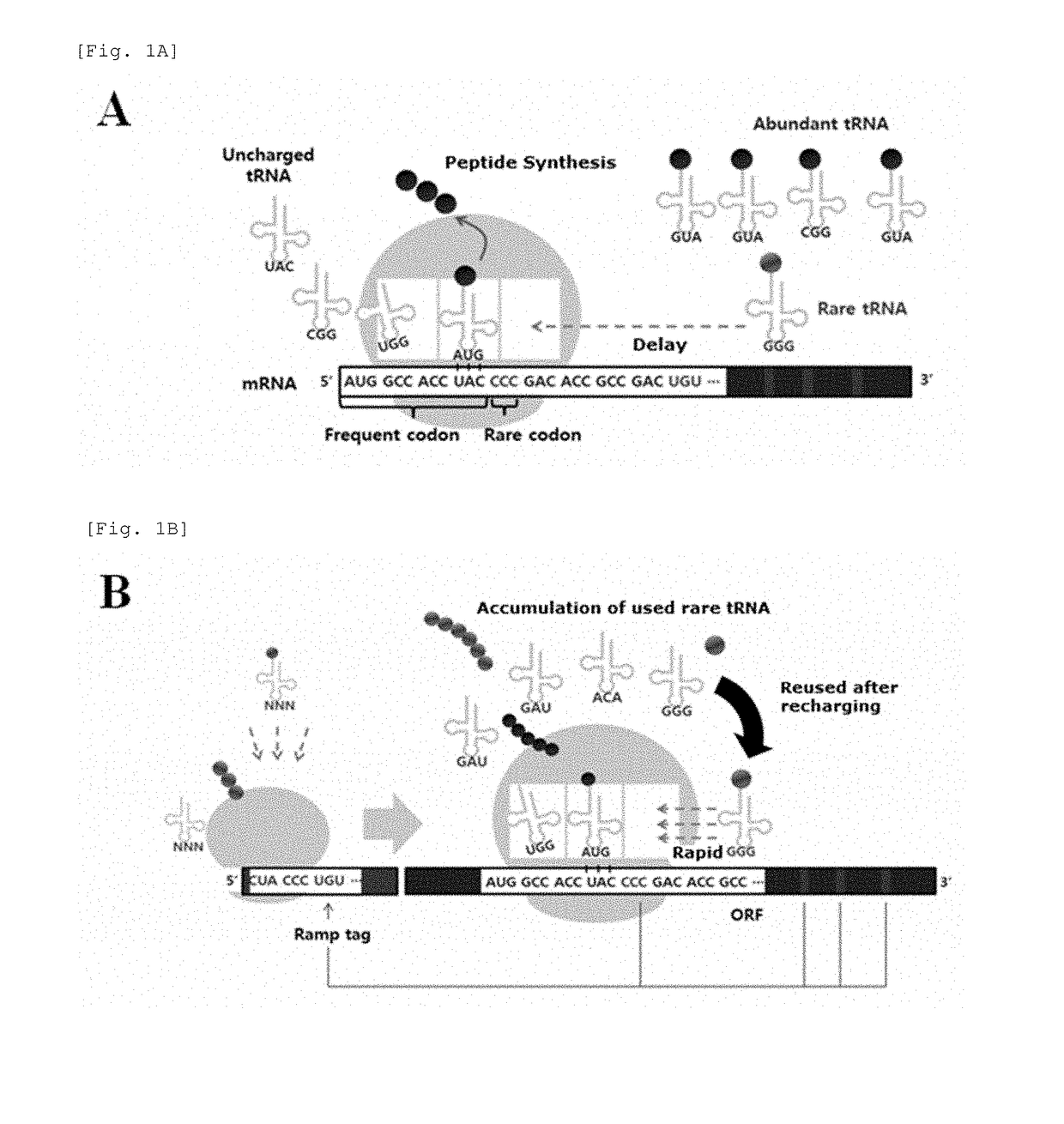Universal protein overexpression tag comprising ramp function, and application thereof
a technology of protein overexpression and function, applied in the field of synthetic tags, can solve the problems of difficult genetic manipulation/regulation process, inability to guarantee the same productivity, and relatively complex physiological/genetic traits of plant hosts, etc., and achieve the effect of increasing translation efficiency, reducing cost, and increasing translation efficiency
- Summary
- Abstract
- Description
- Claims
- Application Information
AI Technical Summary
Benefits of technology
Problems solved by technology
Method used
Image
Examples
example 2
[Example 2] Configuration of Sequences and Construct of Ramp Tag to be Fused with Each Gene
[0091]Referring to FIG. 2A, the ramp tag is configured by the following process: 1. Making rare codon table and preferred codon table depending on host; 2. Converting DNA sequences of target gene into codons; 3. Analyzing frequency and position at which codons in the codon table as made above appear in an open reading frame (ORF) of the target gene; 4. Combining analyzed codons and arranging the codons in the ramp tag; 5. Inducing expression by fusing or substituting the tag at N- or C-terminal inner and outer part (1 to 20 codons corresponding to the tag length) of the target gene.
[0092]According to the configuration of the tag, tRNA required in ORF translation is primarily used when ribosome decodes the tag, and then re-usable in the ORF. FIG. 1B illustrates the translation process and explains operation principle and strategy of the ramp tag. In order to properly operate the ramp tag, the r...
example 3
[Example 3] Analysis of Expression Amount by Ramp Tag Fusion in Fluorescent Proteins DsReD, GFP, and mBFP
[0095]The following Table 5 shows lists of codon sequences of the ramp tag for each gene. The ramp tags consisting of rare codons were prepared by the process of FIG. 2, and were located at N-terminal region to fuse with the target gene, thereby functioned for inducing expression. Over-expression effects of the ramp tag were confirmed by using the constitutive expression vectors such as pBEM3, pRCEMT and an inducible expression vector such as pET22b(+). After the gene is primarily cloned into each vector, the tag sequences of Table 5 (gene-specific ramp tag sequence) were synthesized with a start codon ATG, followed by PCR using each gene as a template, to obtain a gene fragment fused with the ramp tag. Then, a restriction enzyme recognition site of a multi-cloning site was cleaved and cloned, and transformed into E. coli XL1-blue and BL21. The recombinant gene may stably maintai...
example 4
[Example 4] Analysis of Expression Amount by Existing Expression Elements and Ramp Tag Fusion
[0100]The present Example provides a method of using the ramp tag together with typical recombinant protein expression-enhancing elements. An inducible promoter was used as a component of the existing E. coli expression plasmid, and a ribosome binding site (RBS) was introduced in front of an initiation codon of the mRNA for optimized translation. In addition, optimized elements of a transcript secondary structure were included in 5′ untranslated region (UTR). In the case of a mammalian cell, mammalian replication origin (SV40 origin) was included as a component of plasmid, and an inducible promoter was used. For optimized translation, Kozak sequence was included in 5′ untranslated region. The ramp tag was fused by including elements in which a possibility of forming mRNA secondary structure is reduced and splicing signals to analyze expression of the protein. As a result, an increase in an e...
PUM
| Property | Measurement | Unit |
|---|---|---|
| temperature | aaaaa | aaaaa |
| pH | aaaaa | aaaaa |
| pH | aaaaa | aaaaa |
Abstract
Description
Claims
Application Information
 Login to View More
Login to View More - R&D
- Intellectual Property
- Life Sciences
- Materials
- Tech Scout
- Unparalleled Data Quality
- Higher Quality Content
- 60% Fewer Hallucinations
Browse by: Latest US Patents, China's latest patents, Technical Efficacy Thesaurus, Application Domain, Technology Topic, Popular Technical Reports.
© 2025 PatSnap. All rights reserved.Legal|Privacy policy|Modern Slavery Act Transparency Statement|Sitemap|About US| Contact US: help@patsnap.com



